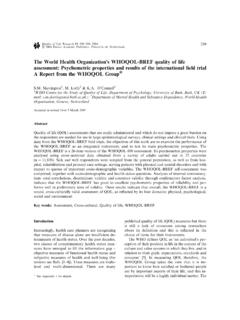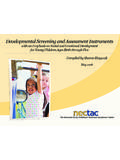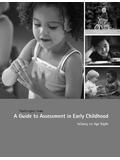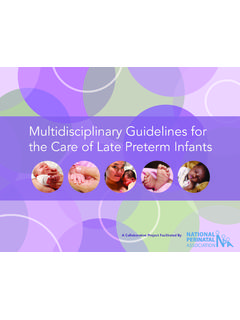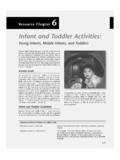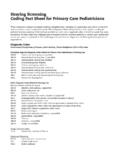Transcription of The Fifth Vital Sign: Implementation of the …
1 March/April 2003 JOGNN199 PRINCIPLES & PRACTICEThe Fifth Vital sign : Implementationof the neonatal infant Pain ScaleAna-Maria GalloSeveral psychometric tools are available toassess pain in the neonate. Although clinically tested,most of these tools have not been integrated into theassessment of the well newborn. Information is lackingregarding the Implementation of such tools and theireffects in clinical practice. The neonatal infant PainScale provides a measure of the intensity of an infant sresponse to pain. This article describes a hospital simplementation of the neonatal infant Pain Scale,including the education provided to nurses and uti-lization of the tool in the assessment of well , 32, 199 206; 2003. DOI: :Assessing neonatal pain Infantbehavioral cues infant pain neonatal infant PainScaleAccepted: May 2002 Integrating comfort measures in daily patient careis inherent in the compassionate, caring professionof nursing, especially in the neonatal setting.
2 Pub-lished guidelines and position statements have high-lighted the importance of comfort measures andpain relief (Jorgensen, 1999; National Association ofNeonatal Nurses, 1995). Recently, however, painassessment and its management has become a focusof care across the United States. Current mandates instate law ( , California) and by regulatory agen-cies (Joint Commission on Accreditation of Health-care Organizations, 2001; Legislative Counsel Stateof California, 2000) require health care profession-als to assess pain each time they record a patient svital signs. Although pain assessment and manage-ment have been essential and integral to the care ofadults, they often have been inadequately providedto newborns (Anand & International Evidence-Based Group, 2001).
3 Until recently, neonatal painwas assessed and managed only occasionally. Inthose instances where infant pain was addressed,documentation often was absent or absence of pain assessment may be due to alimited understanding of neonatal pain and to thedifficulties of implementing assessments and inter-ventions for this population. As a result, proceduresoften are completed without assessment of pain,pain-relieving interventions, or documentation ofthe comfort measures provided to the newborn(Anand & International Evidence-Based Group,2001). Routine procedures, such as a heel stick forblood glucose testing, intravenous line placement,circumcision, or intramuscular injections, are per-formed on newborns.
4 Each procedure causes somedegree of pain. Nurses comfort newborns and alsoencourage their mothers to assist in comfortingthem. Nurses provide little if any documentation,however, of the newborn s pain level and the inter-ventions used to address it. Such lack of documenta-tion was identified as a consistent problem at a largetertiary women s hospital in southern California. Aneducational program was introduced to address themandated requirements of pain assessment in theneonate (Joint Commission on Accreditation ofHealthcare Organizations, 2001; Legislative Coun-sel State of California, 2000) and the adequate doc-umentation of nurses current interventions. Thepurpose of this article is to describe the implementa-tion of the neonatal infant Pain Scale (NIPS) in in the NeonateThe concept of neonatal pain has been a recent focusin health care.
5 Historically, it was thought that newbornswere incapable of experiencing pain (National Associa-tion of neonatal Nurses, 1995; Stevens, Johnston, &Grunau, 1995). Misinformation was based on the per-ception that infants lack pain transmission following reasons were the basis for this mispercep-tion: the incomplete myelinization and immaturity of theinfant s nervous system, the infant s inability to exhibitdiscernible responses to painful procedures, the infant sinability to remember pain, and the fear of addiction asso-ciated with the use of pain medication (National Associa-tion of neonatal Nurses, 1995; Stevens et al., 1995).Recently, through research, these beliefs have been dis-pelled. Studies have shown that infants are capable ofexperiencing pain and that they respond to noxious stim-uli.
6 Healthy full-term infants display vigorous grossmovement and withdrawal from the painful stimuli(Stevens et al., 1995). Physiological and behavioralresponses have been seen in the neonate in response tonoxious stimuli (Stevens et al., 1995). Recently, evidence-based guidelines for the management of neonatal painhave been introduced as a result of collaboration amongexperts from several different countries (Anand & Inter-national Evidence-Based Group, 2001).Although pain is multifactorial, an awareness ofbehavioral cues is one component of neonatal painassessment. Behavioral responses include facial expres-sion, body movement, and crying (Johnston & Stevens,1990; Jorgensen, 1999; Pain in Newborns, 2000;Stevens & Johnston, 1993; Stevens et al.)
7 , 1995). Pain innewborns is often unidentified because of their inabilityto communicate, or is unappreciated or misunderstood(Buchholz, Karl, Pomietto, & Lynn, 1998; Franck, 1998;Jorgensen, 1999). Nevertheless, the communication ofinfant pain is identified through the recognition of thesebehavioral addition to such behavioral indicators, neonatesexhibit a wide range of physiological responses to painfulstimuli as a result of the activation of the sympatheticnervous system (Stevens et al., 1995). Precise, objective,quantifiable information concerning the neonate sresponses to noxious stimuli can be identified throughthese physiological responses (Stevens et al., 1995).Changes in physiological indicators include increasedheart rate, respiration, blood pressure, and oxygen satu-ration (Johnston & Stevens, 1990; Jorgensen, 1999; Pain in Newborns, 2000).
8 Other physiological respons-es include palmar sweating and increased intracranialpressure and cortisol levels (Stevens et al., 1995).Although physiological indicators can aid in the evalu-ation of pain, nurses must recognize that, on their own,such signs are not always accurate indicators of pain (Kee-ble & Twaddle, 1995). Stimuli such as hunger, fatigue, andanger may elicit similar changes not necessarily associat-ed with pain (Fuller & Neu, 2000; Stevens & Johnston,1993). Through an appreciation of these physiologicparameters and behavioral responses, health care profes-sionals have the ability to assess pain in the Tools for neonatal PainSeveral pain assessment tools are based on the knowl-edge that infants exhibit physiological and behavioralresponses to noxious stimuli.
9 Two criteria were Vital forthe selection of an appropriate tool by the southern Cali-fornia facility. First, the assessment tool needed to incor-porate nurses existing newborn assessment skills, andsecond, the tool had to be easy to use. Although an in-depth review of all existing infant pain scales is beyondthe scope of this article, a brief discussion will focus onfour assessment tools CINAHL (Cumulative Index to Nursing and AlliedHealth Literature) search was conducted to explore new-born pain assessment instruments reported in the litera-ture. The tools most frequently cited were the PrematureInfant Pain Profile (PIPP) (Stevens, Johnston, &Petryshen, 1996), CRIES: neonatal Postoperative PainAssessment Score (CRIES) (Krechel & Bildner, 1995), neonatal Facial Coding System (NFCS) (Grunau &Craig, 1987, 1990), and the neonatal infant Pain Scale(NIPS) (Lawrence et al.)
10 , 1993). Literature related to allthe instruments described the development and testing ofthe tools. None of the articles described the tools appli-cation in clinical first instrument reviewed was the PIPP (Stevenset al., 1996). The PIPP is a behavioral and physiologicalassessment tool, which provides a measure of the prema-ture infant s response to pain. Scoring indicators includegestational age, behavioral states ( , active, awake,asleep, quiet), heart rate, oxygen saturation, brow bulge,eyes squeeze, and nasolabial furrow. The PIPP is the onlytool that accounts for the infant s gestational age, thusallowing the distinction between behavioral differencesamong full-term and preterm infants. The PIPP requiresadditional equipment and assessment parameters not200 JOGNNV olume 32, Number 2 Although pain is multifactorial,behavioral cues offer one componentin assessing neonatal used in the well newborn population ( , bloodpressure readings and oxygen saturation).
